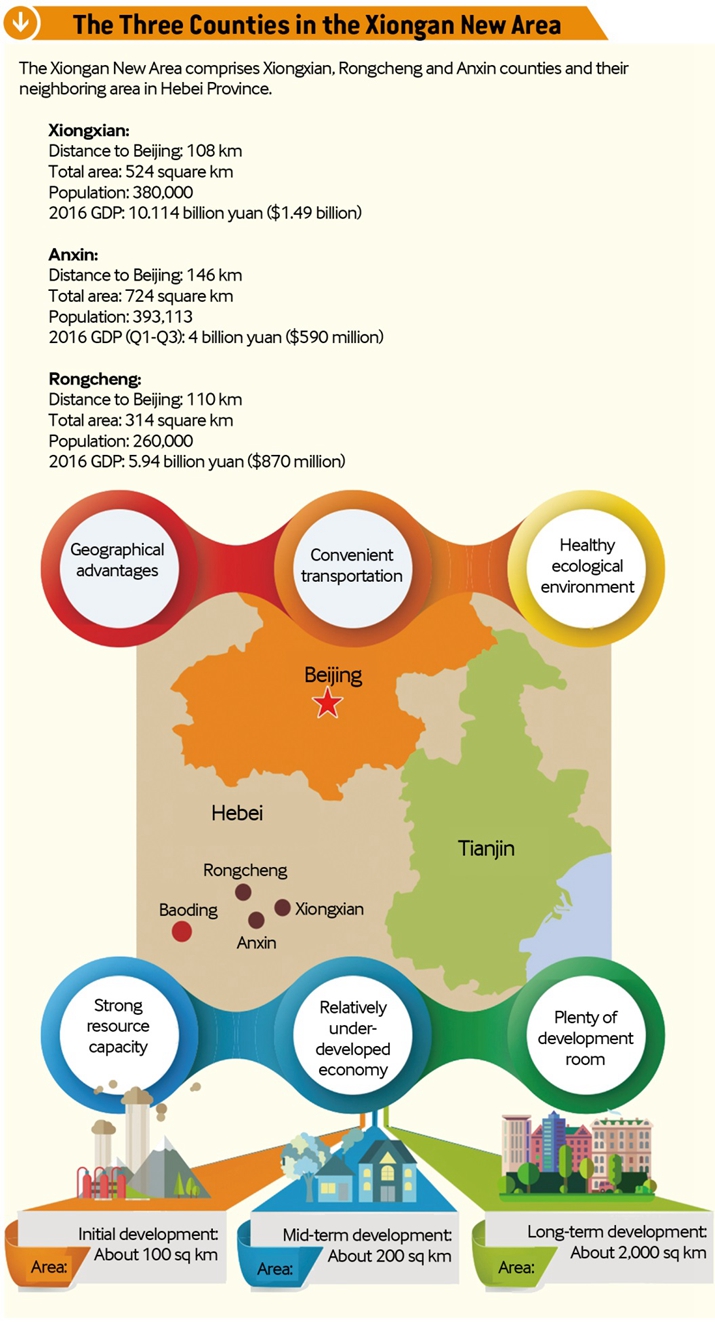 |
 |
| Brand new start | ||
| By Yuan Yuan | ||
Three small counties resting in the middle of north China's Hebei Province had stayed silent for years until breaking news, released on April 1, brought them all the way to the front stage to sparkle in the spotlight. The three places, Xiongxian, Anxin and Rongcheng, under the jurisdiction of Baoding, Hebei Province, will form a new development zone, the Xiongan New Area, to parallel the Shenzhen Special Economic Zone and the Shanghai Pudong New Area, China's successful test beds for reform and opening up. The new area will initially occupy 100 square km and eventually 2,000 square km. Why there? The decision to establish the new area, about 100 km southwest of downtown Beijing, is part of a greater strategy, which China initiated in 2014, to jointly develop Beijing, the port city of Tianjin and Hebei Province to improve the region's economic structure, environment and public services. The distance of the new area from both Beijing and Tianjin is about 100 km, the same as that from Beijing to Tianjin, which makes the interconnected area resemble an equilateral triangle. "The site of the new area was carefully chosen," said He Lifeng, Minister of the National Development and Reform Commission (NDRC), during an interview with Xinhua News Agency on April 5. "The choice is based on practicality after rounds of comparison and rigorous research by experts. The new area is part of measures to advance the coordinated development of the Beijing-Tianjin-Hebei region." The transportation connections of the new area, according to He, will be very convenient, with Beijing, Tianjin and Shijiazhuang, capital city of Hebei, all within a half-hour's commute. The Baiyangdian Lake, the largest freshwater lake in north China, is located in the zone, which will make the zone ecologically healthy with a relatively strong environmental capacity. Beijing now is home to over 21 million people, and the number is expected to reach 23 million in 2020. Traffic congestion, soaring property prices and excessive burdens on resources are all severe "urban ills" of the huge capital. The root of these issues lies in the capital taking on too many "non-capital functions," and Beijing has long been considering curbing population growth and relocating industries and other non-capital functions to Hebei in the coming years, said the NDRC head. Nie Huihua, a professor of economics at Renmin University of China, told Caixin, China's leading financial and investigative news organization, that now the picture is becoming clearer: Many of Beijing’s metropolitan functions will be transferred to its Tongzhou District and the Xiongan New Area will shoulder part of Beijing's non-capital functions, such as the development of hi-tech industries. Tongzhou and Xiongan are now like Beijing's two wings. Beijing will focus on its "capital functions," which means serving as the country's political center, cultural center, and center for international exchanges and science and technological innovation. Another major task of the Xiongan New Area, Nie said, is to promote Hebei's economic and social development and help develop the Beijing-Tianjin-Hebei region into a world-class metropolitan area. Xinhua stressed the development of Xiongan as the country's "big millennial plan," a term that has rarely been used before, which shows both the strategic significance of this project and the difficulty of assessing its success in the short term. New way ahead On April 1, Xu Qin, former Shenzhen Mayor and Secretary of the Communist Party of China (CPC) Shenzhen Municipal Committee, was appointed as deputy secretary of the CPC Hebei Provincial Committee. Many people expect him to make use of his nine years of experience in Shenzhen to aid the development of Xiongan. However, Xiongan will not be able to compare economically with Pudong or Shenzhen in the near future, said He Lifeng, Minister of the NDRC, on April 5. Instead, Xiongan may prove to be a place where the Central Government can focus on its experiments with urbanization, supply-side reform and even governance models. Xiongan will be an answer to China's growth conundrum: Breakneck urban sprawl must give way to a strategy of balanced and inclusive development. Protecting the local ecology will be a priority, as the authorities do not want to repeat the outdated practice of "pollution first, treatment later." People will live in a cleaner and safer environment. Master and detailed blueprints of the new area and a plan on the ecological conservation of the Baiyangdian region are among the first plans to be mapped out, He told Xinhua. The NDRC chief pointed to reform as a key to development, saying that new administrative, investment and financing models will be tried in the new area. Innovation will be the fundamental driver in building and developing the Xiongan New Area, and policies will be put in place to bring innovative elements to the area, said He. Xu Kuangdi, head of the expert advisory committee on the collaborative development of Beijing, Tianjin and Hebei, suggested that the construction of the Xiongan New Area should focus on technological and innovative industries and the region should attract high-end innovative talent and resources. He emphasized the point by saying that the new area will create a favorable environment for innovation and attract innovative talent and teams to help build it into a "high ground" for innovation and a new science and technology city.
 |
| About Us | Contact Us | Advertise with Us | Subscribe |
| Copyright Beijing Review All rights reserved 京ICP备08005356号 京公网安备110102005860号 |